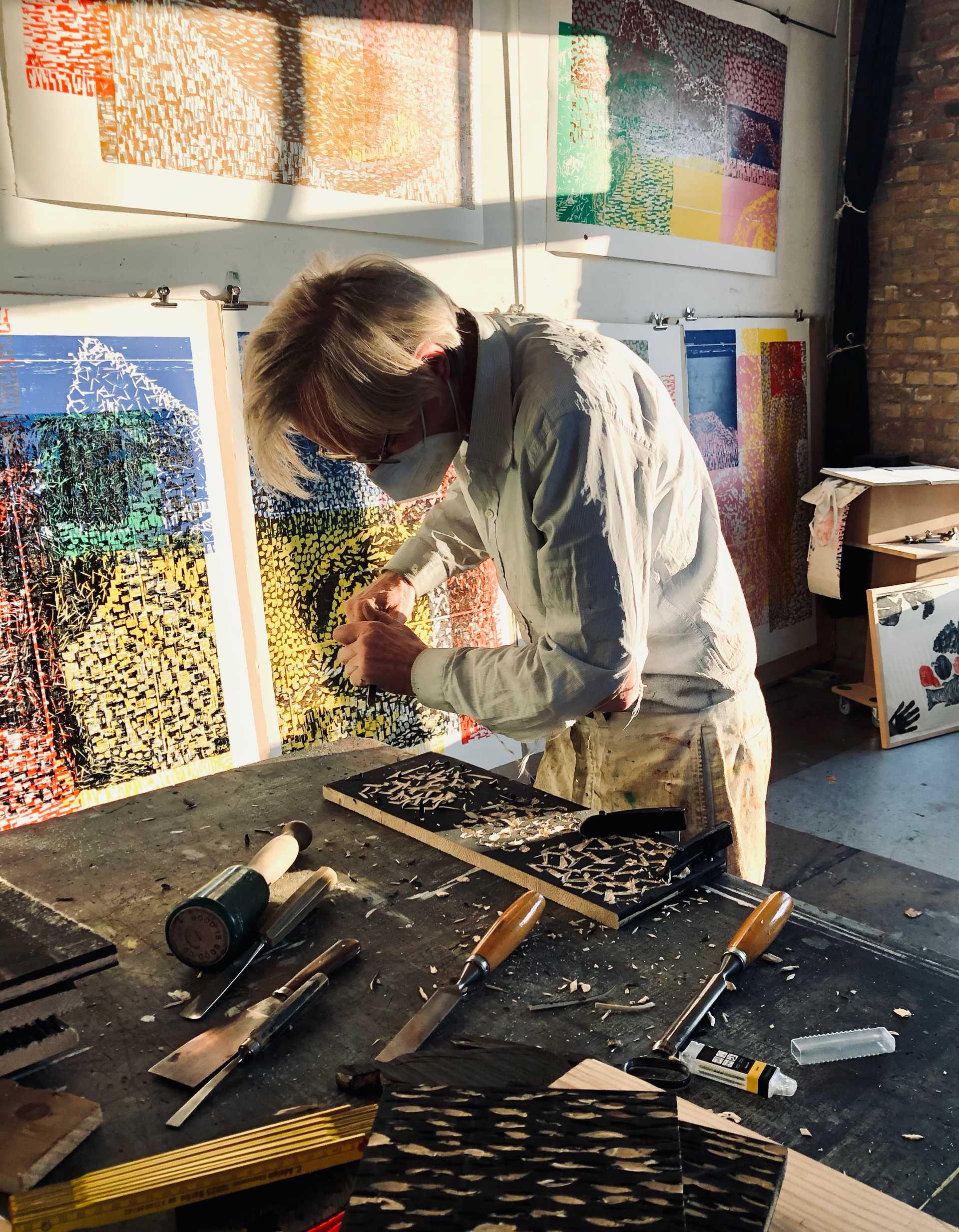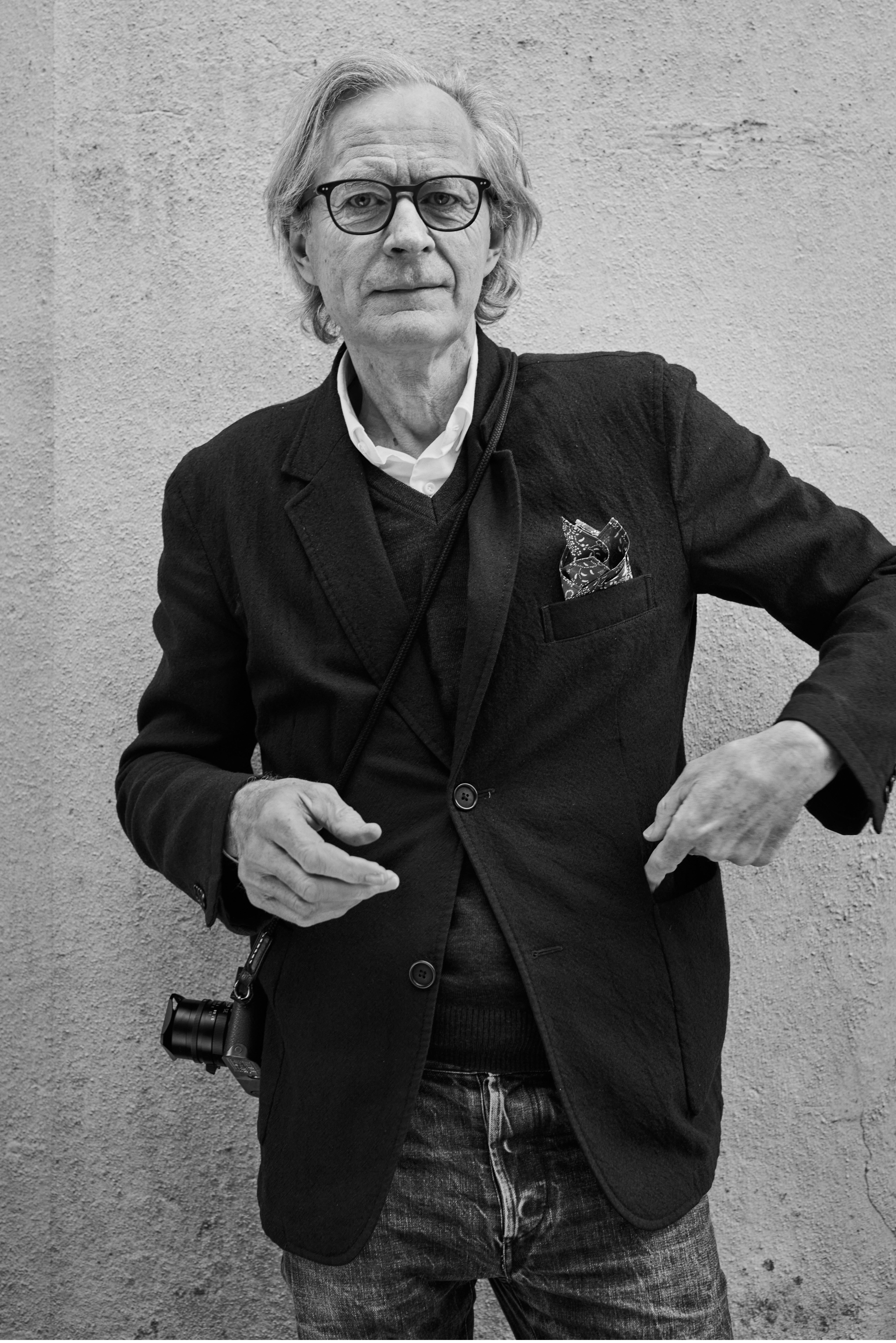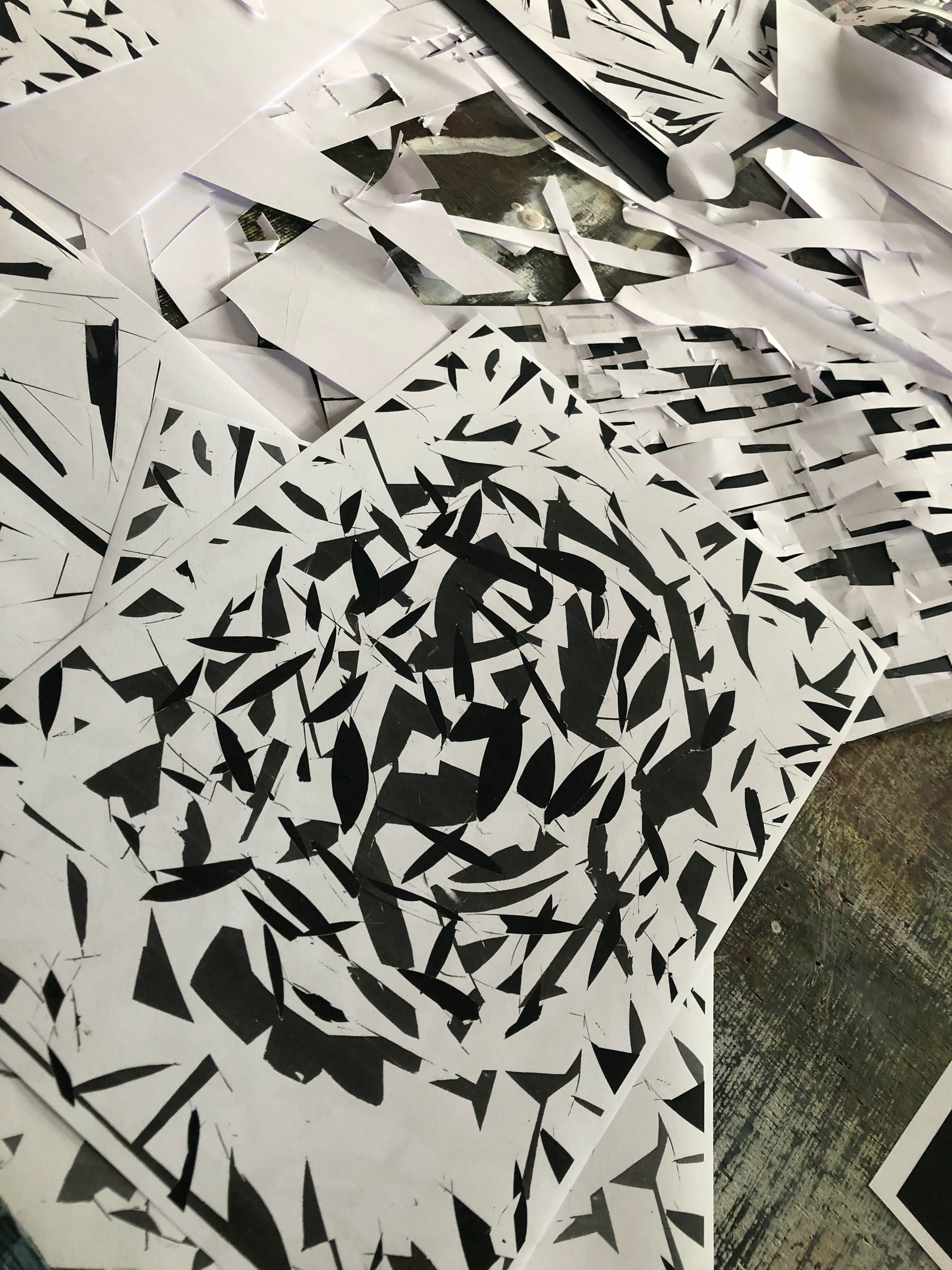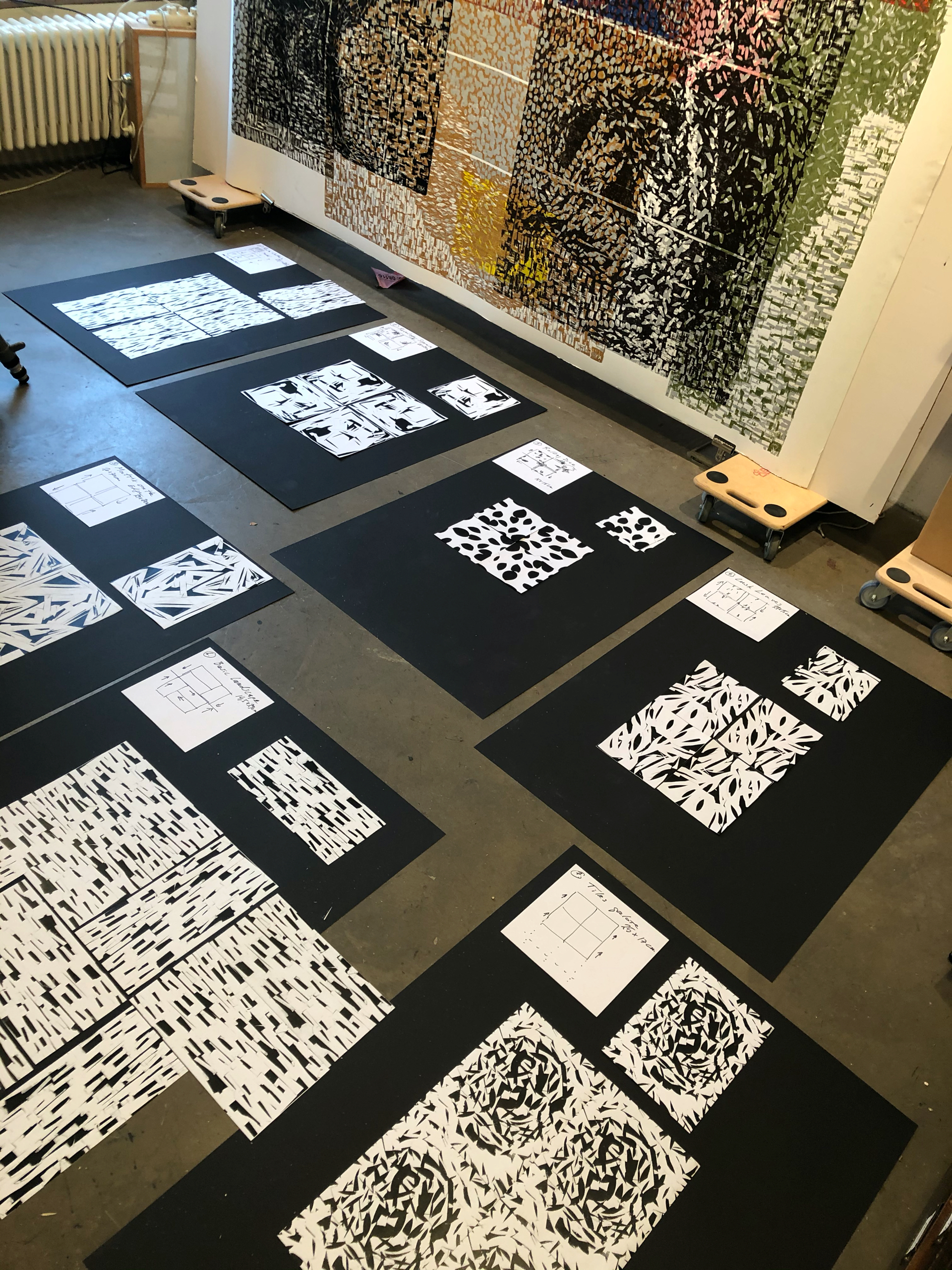Could you please briefly describe your artistic career?
I am a visual artist who lives and works in Berlin. I began by studying painting at the Academy of Fine Arts in Karlsruhe in the early 1980s. I was completely focussed on painting; my two professors Georg Baselitz and Markus Lüpertz fascinated me. But at that time I also started making posters for the art academy. So it was really by chance that I discovered the medium of woodcut for myself. Even then I was working with salvaged wood panels, found wood, just as I do today. In 1985 I came to Berlin, and from that time on really developed the medium of woodcut for myself.
What is your artistic process when you carve woodcuts?
Salvaged wood is something that has remained in my work. I just find it very exciting when boards have a history, when something is already inscribed in them. My last large urban series, Potsdamer Straße, shows the neighbourhood immediately around my studio. I cut the series from floorboards that I had pulled out of demolition containers here. You could already see partial traces of life in the wood as well as the grain of the wood. I find the threefold quality of the wood extremely interesting; the wood was worked and used, it therefore served a purpose, and at the same time it still presents itself in its nature. I usually work with abstract cutting sequences, structures and rhythmic structures formed by flecks of light. From a sequence of abstract specks of light, a representational image emerges in the viewer’s eye; sometimes it comes closer, and sometimes it is further away. That is the fundamental quality of this technique.
So why did I stay with the woodcut? It actually has to do with the fact that I realized that, unlike painting, woodcut is a medium that demands a great deal of certainty. I can produce an “injury” to the surface of the wood through some form of tool. Whether I am working with a knife, a nail or a hammer – as soon as I have carved the material, made a notch, it is always an existential moment.
I found this unambiguousness incredibly attractive compared to painting. The second point that then became very important for me was my serial approach. I can work on a wooden block, then make a print of the cut motif and then, in a second stage, rework this block again and make another print. And so on. This way I always create an image that reflects exactly what I have cut. At the same time, I also have a narrative – a documentation – of my artistic process. So I have an image and a document at the same time. This has basically become the engine of my work.

You came to the technique of woodcut through posters, and you also collaborate with printing workshops. Do you do this frequently?
These days I largely work independently, and I only rarely accept commissions. I have made some original posters for my own exhibitions. But every now and then an opportunity arises and I accept a commission. I still sometimes print original cards and also artists’ books. With the artists’ books, I’ll work with a printing workshop, and communication is an important part of the process. For example, there is the question of how to scale up the printing process, which I usually do for myself as a one-time process in the studio, making only one or two prints. With a printing workshop, however, you have to turn it into a serial product – and this of course presupposes converting my distinctive way of working into a mechanical production process, so to speak. I find that very exciting. That’s why I’ve always enjoyed such commissions.
"I don't cut lines, I cut light."
So you have experience in the collaborative field from working with printers on artists’ books. How would you describe this kind of collaboration?
It is an exciting communication process – and one that we have to build up. Conversation is a major part of this, and so of course is physical presence. For me at least, it’s absolutely crucial to be present in the workshop. I have to observe how the printers work and see what colours they have on hand. How do I achieve the colourfulness that is so important to my work using the colours that are available in the printers’ workshop?
There is also a fundamental aspect of my work to consider. In my studio, I ink by hand, using a hand tool. This means that I can only obtain a relatively low contact pressure. Also I use a lot of highly pigmented ink – in my case, ink that is typically used for etchings. But in the printing workshop, of course, it’s the other way round. You have a cylinder weighing several tons that runs over the printing plate and paper, and you work with a lot of pressure and a minimal amount of ink. Of course I still want to achieve a certain effect, even with these different means, and that involves a very complex process of realization. You also have to take into account that the found wood I use as printing plates in my studio is generally warped and bent – the boards no longer lie flat. An effect like that simply cannot be achieved on a printing press. The press ultimately requires standardization. When I collaborate, I have to keep all of these factors in mind.
"The motto of my work is thinking with head and hand. How to bring the physical and cerebral into one work."
You came to your collaboration with the indigo dyers with good prior knowledge of the production principles involved in using a different medium. When you work on a design that you know is going to be printed on textile, how does that differ from conceptualizing your work on wood?
With my own work, there are different creative triggers. Usually I start with a thought or an idea, which I then try to implement.
When you invited me to carve a mould for indigo printing, it was of course quite challenging, because I don’t usually imagine the end product as a thing in itself. Usually I picture the artistic process in sequences; I progress experimentally with that process and make the stages of the process part of my work. My prints usually document both progress and process. It is very rare for me to envision only the final stage as the product.
So in this case, I thought about how I could make my artistic approach productive for the design. I came up with the idea of taking a paper cutter and typewriter paper and using these to produce different design lines. These were mostly associative – motifs like dots, rain, Islamic woodcarvings, carpet weaving. And in the process I cut something, much as I do in woodcutting. At the beginning of the process, when I cut into a board like this, I start with relatively little information, and in the course of cutting and printing, more and more information is added. At the same time, however, I destroy material. There are printing blocks of mine that are no longer printing blocks at all when the print is finished – they are just a pile of wood splinters. So there is a give and take: loss of material – gain of information. I am intrigued by the idea of transferring this principle of loss and gain to other ways of working.
In this case, I thought: I’ll take the knife and cut wildly abstract shapes into the paper until at some point it’s gone. But then I can put it on a piece of black cardboard and make a photocopy. And because only the black shapes will then appear, I’ll get the information back in a digital way, and then I can begin cutting again. In this way, the process of cutting – an analogue process – actually merges with the digital process of copying. This mechanical process creates a new configuration. I found that extremely appealing. And I ended up doing it with different motifs.
And then made/in brought a third aspect into the mix, something that I had somehow not thought of at all: the rapport. I had not thought that this sort of rapport was possible; I had thought you just can’t turn something unique into something repetitive, that it just doesn’t work. So my approach was to make these interventions so drastic that no one would miss the rapport; they would not know where it begins or ends – more of an eye-dazzler, where the eye just can’t keep up. But the designers at made/in were not entirely convinced by this approach. For this reason, I would like to continue to develop the model. I picture something like an analogue direct handcraft intervention converted via a digital format and then converted back to the analogue printing block such as a printing mould – or even as a digital programme for a loom. I can imagine a lot there. I find it very exciting that analogue forms of thinking – and thus craft processes for obtaining information – are then transformed back into craft processes by means of a digital medium. I have the feeling that this interests all of us at this point.
It was also wonderful to visit the indigo print atelier in Jever to see how they work and to draw conclusions about what characteristics the new mould should have.
Yes, I realized during our visit to Jever that I really didn’t know how the traditional indigo printing process worked at first. When I saw the original printing materials and the old moulds, I understood that the woodcut there is more of a line cut. You can cut ridges, bars or islands. I tend to cut islands. But with the traditional indigo printing moulds you basically work more with ridges or bars. So you can jump between negative and positive shapes. It was important to see first-hand how indigo printing is done and what kind of source material is needed from me as an artist. Before we developed the new mould, for example, none of us knew that indigo printers are used to having little markers on the printing block for the mould’s starting points during the printing process.
It was also extremely interesting to see how deeply the mould has to be cut. In my other work, the woodcut shape is only created by a mere surface injury. But with indigo printing, you need deep ridges and burrs, which should ideally be raised four millimetres. These prerequisites are of course quite different.
Since the early twentieth century, hand-made textiles and the mechanization of textile production have often been seen as opposing each other – as the mutually exclusive ends of the spectrum. You seem to view this juxtaposition differently.
“Thinking with head and hand” is my motto. How can you incorporate the physical and the cerebral into one work at the same time? That has always fascinated me, and I would be extremely reluctant to forego one or the other. All of the techniques that interest me are always located exactly at this transitional threshold. For me, the discovery that I could work on an image and document its creation at the same time in a textile medium was exciting. This allowed me to reveal my artistic thought process. The individual artwork is simply the outcome of a working process and not the result of an aim towards a specific image. I have now applied this principle to our collaboration. I was thinking about how to push this even further – this transition from an analogue intervention (i.e., me with the cutting knife) to a digital reproduction – and thus try to push the game back and forth.


